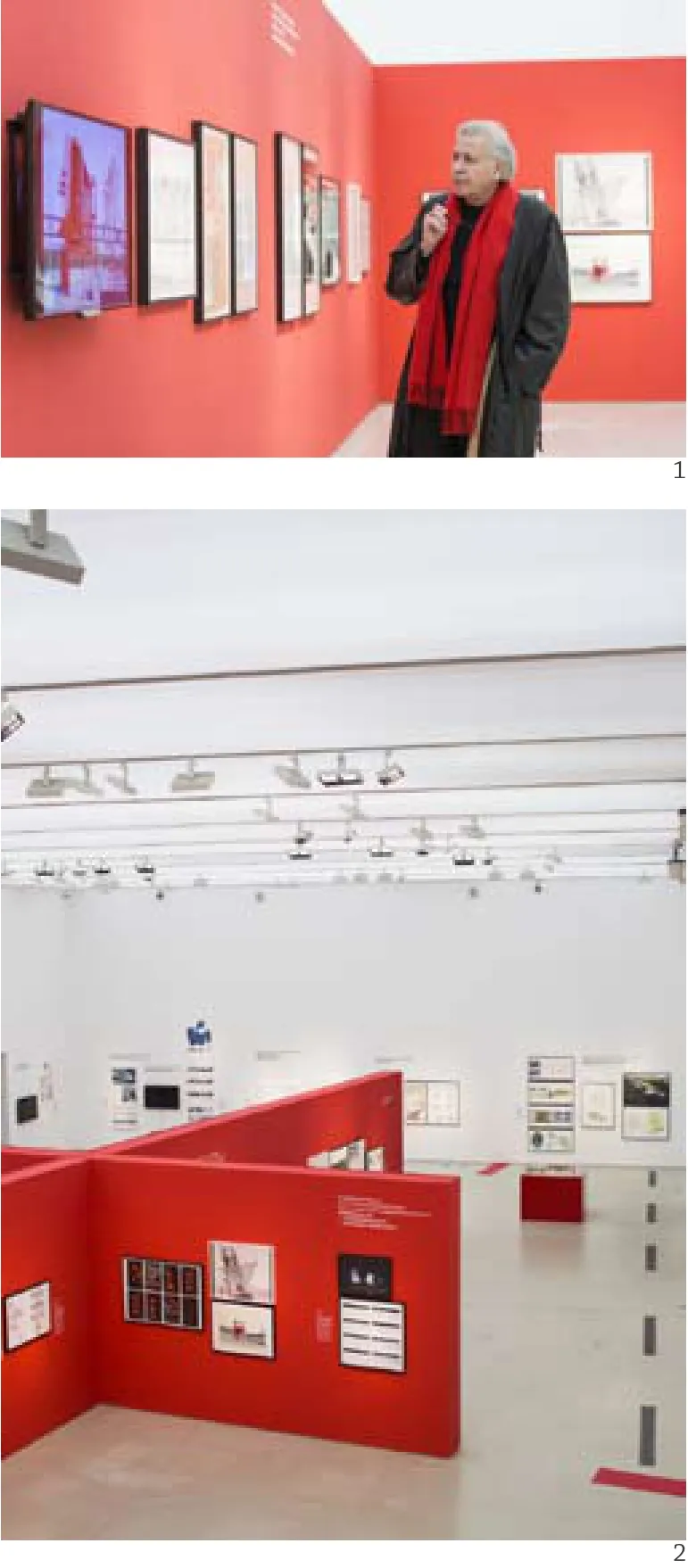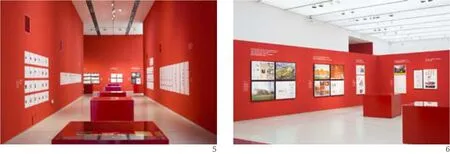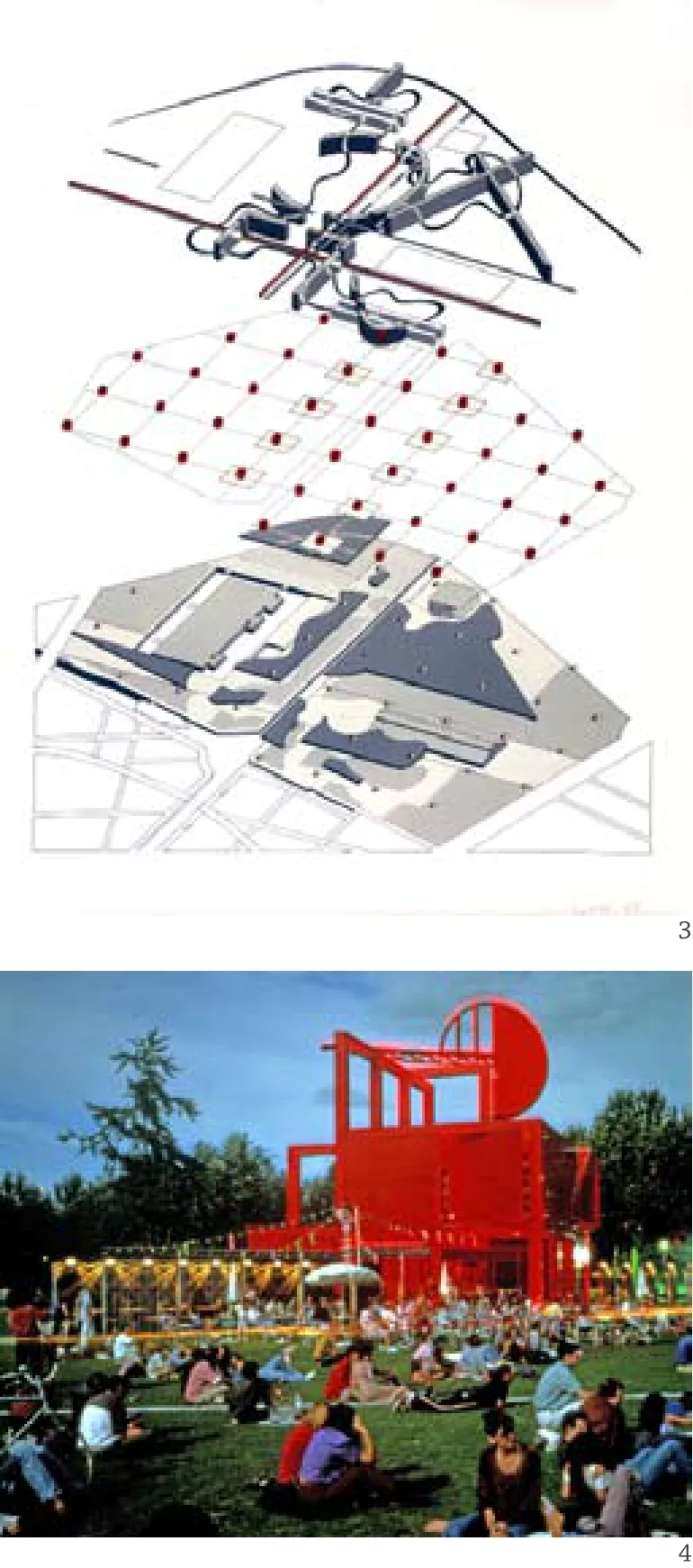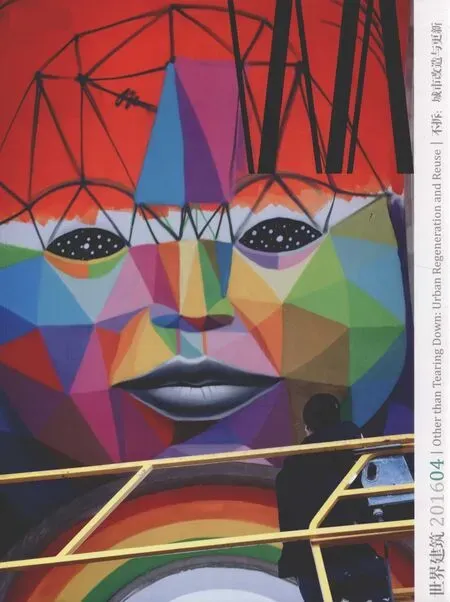伯纳德·屈米访谈
叶扬 采访/Interviewed by YE Yang
王欣欣 译/Translated by WANG Xinxin
伯纳德·屈米访谈
叶扬 采访/Interviewed by YE Yang
王欣欣 译/Translated by WANG Xinxin
2016年3月13日-6月19日,“伯纳德·屈米——建筑:概念与记号”展在上海当代艺术博物馆举行,在展览开幕后,《世界建筑》对伯纳德·屈米进行了简短的访谈。
WA:您的父亲是一名优秀的建筑师。请问他是否对您产生了影响?
伯纳德·屈米:我的父亲的确是一名优秀的建筑师,并且在我挺小的时候就去世了,因此我没有太多机会与他讨论建筑。我的作品是相对独立地形成的。实际上,我受到了1968年“质疑”时期的影响。毕业后的那段时间是我进行建筑设计实验的阶段,先是在伦敦后来在纽约,我进行了很多探索,但都与真实的建筑有所不同。多年之后,我才逐渐理解了我父亲作品中的建筑内涵与构造艺术,并且非常认同。然而,在早期,(我们之间的交流)那是完全分离的。
WA:您著名的拉维莱特公园是一个建筑通过形式干预表达社会批判的代表作品。这是否受到了德波的情境主义思想的影响?
屈米:是的,我对情境主义有比较强的意识。德波对城市感兴趣,我也对城市感兴趣,甚至我对城市的兴趣要远远大于对于建筑单体的兴趣。比如,德波曾提出“漫游”的概念,即在某个城市环境中随意地行走。因此,当我设计拉维莱特公园时,我说过它不仅仅是一个有着自然景观的公园,而应是城市的一个片段——一个有着树景的城市片段。它需要的是活跃的、与文化相关的,并且引发人与人的邂逅和互动。于是我设计了点、线和面的系统——行动发出的点、运动产生的线以及自发行动形成的面。同样,我也确信影响我的不只是情境主义,还有电影,比如让·吕克·戈达尔的电影,以及哲学家,比如雅克·德里达,他们都在质疑陈词滥调,试图创造新世界。
WA:作为“1968一代”的建筑师,对于当代建筑,请问您在广义的人类发展层面上有何看法?
屈米:对于当代的情况,我的批判在于,现今,建筑师倾向于关注“物”、标识,以及那些代表了某种意象的建筑。我们对于建筑之间存在的相互关系、城市的运作机制关注得不够多。这是一个我们需要再度关注的方面。
The power Station of Art hosts the architect and theorist Bernard Tschumi's exhibition BERNARD TSCHUMI - Architecture: Concept & Notation,which opens to the public on March 12th and runs through June 19th. World Architecture interviewed with Benard Tshumi after the openning.
WA: Your farther was a very good architect. Did he have any influence on you?
Bernard Tschumi (BT): My father was a very good architect, and died when I was quite young. And I had not much opportunity to talk about architecture with him. I developed my work quite independently. And it was another era, I was influenced by the 1968 era of questioning, and after I finished my studies I was really in an experimental phase. In particular first in London and then in New York, I developed a lot of explorations, quite different from the real building. But it's much later when I started to build that I started to understand the architecture of sophistication and the art of construction of my father's and liked it very much. But in the early days it was completely, completely separate.
WA: Your most well-known work, parc de La Villette was one of the signs that architecture shows social critique through the form intervention. Did it have anything to do with Debord's situationism which was an important thought?
BT: Yes, I was very aware of Situationism. Debord was interested about the city, I was interested about the city, and I was even more interested about the city than I was interested about buildings and individual architecture. For example, there was a concept by Debord called, "dérive" in French, or "drift" in English, which means walking at random in an urban environment, so when I started to work on La Villette, I said it's not a park of nature, it's a piece of the city, but a piece of the city with trees, so it had to be active, it had to be cultural, it had to be the encounter and the interaction between people,and that is how I devised the system of points, lines and the surfaces-the points of actions, the lines of movements and the surfaces of spontaneous action.

1伯纳德·屈米/Bernard Tschumi
2“伯纳德·屈米——建筑:概念与记号”展览现场/The exhibition BERNARD TSCHUMI - Architecture: Concept & Notation


3拉维莱特公园轴测/Axonometric of parc de La Villette
4拉维莱特公园/parc de La Villette
WA:在法国国家图书馆的竞赛方案中,您曾经设计了一条跑道。然而方案并没有入选。多年之后,却有很多建筑采用了这个想法,其中包括一些中国的建筑。对此您怎么看?
屈米:法国国家图书馆的方案确实是一个引发争议的表达,不过它是一个引发争议的严肃表达。对此我所指的是不同的功能是可以并存的——图书馆并非只能有书,音乐厅并非只能有音乐,美术馆并非只能有美术作品——生活并非仅仅如此,生活中的各种活动是互相交织的。而建筑师应该是那个提出交点的人。现在,我们可以看到机场里不仅有酒店,还有商场、会议中心和教堂,它们都是并存的。这就是生活的演变。在图书馆的那个例子中,我设计了一条跑道,因为我曾说过——21世纪的运动员将会是知识分子,而21世纪的知识分子也将是运动员。不过我想那个时候提出这个理念太早了,评委们一个劲儿地摇头。
WA:为何“符号”的概念对您的研究和设计那么重要呢?
屈米:原因其实很简单。在想要描述运动的时候——关于人体在空间中的运动——或者想要描述活动和事件的时候,建筑师往往不具备充足的工具。我们会运用剖面、平面、轴测、透视图,但这些都是非常静态和被动的方式。如果想要描述建筑的动态使用,例如运动,则需要发明新的符号系统,因为它们并不存在。这是很复杂的事,原因在于我们还没有形成有序的系统,并且只有少数建筑师愿意这么做——我们发明自己的系统,甚至是每次一个新的系统。但这仍然是非常重要的,这就是我所指的“符号”。这个词语受到了音乐记谱法的影响——音乐家/作曲家会为同时演奏的不同乐器写不同的谱子,钢琴一行、小号一行、小提琴一行……而建筑师也应该做到这点。更重要的是,符号中包括了“时间”。因此,我希望建筑符号是既包括空间也包括时间的。动到另一个更隐蔽的空间,诸如此类。这是很重要的概念。但是还有“文本”——人们谈论建筑。我认为这其中的结构也是很重要的。当人们讲故事的时候,会有一个叙事结构存在其中。我想有些书籍是可以帮助大家理解这两个概念在建筑层面的区别的。我推荐一本由伊塔洛·卡尔维诺著作的《看不见的城市》。这是一本非常美丽的书,因为它一直在讲同一座城市,然而以完全不同的方式。这可以让你理解城市的重要性,并且每次都以新的方式。建筑是关于世界的,并非仅限于建造各式各样的好看的物体。
WA:您一度尝试区分认知的形成和形式的认知,但是请问在设计过程中您是如何看待知识可视化的难题呢?
屈米:当我用手机或使用网络,它并不具备一个可见的形态,但是却创造了认知。这个认知应该被理解为一种补充。也就是说,它们互相配合。当我通过电子媒体接收到复杂信息的同时,也通过环境接收信息,我认为这将会使我们的生活更丰富。因此我对我们社会的未来是乐观的。然而,这并不是因为我们理解形式,这是因为我们拥有对于形式的认知。
WA:在当今虚拟网络迅速扩张的背景下,该如何理解空间和事件的关系?
屈米:你们提出的问题都很好。的确,虚拟网络正在改变我们互联的方式,公共空间发生了改变。之前,广场和街巷是非常重要的社交维度。而今,比如说,GPS已经完全改变了我们在城市中行走的方式。我们互动的方式、和他人会面的方式,也都未必和从前一样了。人们不再去广场见面和交谈,而是互相发送信息。因此,我们需要开始理解这个新的电子虚拟网络对建筑的影响。然而,我认为现在还没有对于这个问题的答案,这将是接下来20年我们需要解决的挑战。(本文感谢建筑学者范路、周渐佳的帮助)
WA:对于叙事空间和文本空间的区别,您的观点是什么?
屈米:这又是一个好问题。“叙事空间”仅是指人们从中移动到另外一个空间的空间。例如,在所有的文化和宗教中,都有叙事空间。人们从一个空间移There's no question what was being done at the time was not only influenced by the Situationist, but also by films, films like Jean-Luc Godard's, or philosophers like Jacques Derrida who were questioning clichés and were trying to invent a new world.
WA: Being regarded as an architect from the generation of 1968, what is your opinion on the contemporary architecture related with human development in a broader sense?
BT: Regarding the contemporary situation, my criticism would be that, today, we architects tend to look at "objects", at icons, at buildings which are an image; and we are not looking enough at how building relates to one another, and how the city works. This is something that we have to now concentrate again about.
WA: In your competition entry of la Bibliothèque Nationale, there was a running track in your proposal, but it was not chosen. After years, a numbers of buildings used this idea, including some Chinese buildings. Do you have any comments?
BT: The Bibliothèque Nationale was of course a polemical statement, but it was a serious polemical statement. I was saying that programs can mix with one another, that you don't have to have a library with only books, or you don't have to have a concert hall with only music, or you don't have to have a museum with only paintings, that life is different,life intersects different activities. And the architect should be the one to propose the intersection. Well, you have seen now that airports have hotels,shopping malls, conference centers and churches, all at the same place. That is the evolution of life. In the case of the library, whereas, I proposed that there would be a running track, because I said that the athlete of the 21st century will be an intellectual,and the intellectual of the 21st century will be an athlete. I think it was too early for that time, and they said "no, no".
WA: Why the concept of notation is so crucial in your research and design?
BT: The reason is very simple. If you want to talk about movement, about the movement of the body in space, if you want to talk about activities and events,then the tools of architects are often not sufficient. We learned to use sections, plans, axonometric,perspectives, but all these are very static, very passive means. If you want to talk about dynamic use of the building, like movement, you have to invent new systems of notation-they don't exist. It is very difficult to do that, because we don't have yet an organized system, there are few architects would do this, like us, and we all invent our own system,even from one project to the next. But it's still very important, and that is what I call "notation". The word was inspired by music notation, where the musician/ the composer can have one line for the piano, one line for the trumpet, one line for the violin, architects should be able to do that. More importantly, it is in "time". So I would like architectural notation to be about both space and time.
WA: In your opinion, what is the difference between space of narrative and space of text?
BT: This is also a good question. A narrative space can be only a space where you move from one space to another. For example, in all cultures and religions, there are narrative spaces, you move from one space to a more secret space and so on-that's important. But there is also the "text"-they talk about architecture, which I think are also important in terms of their structure. When you tell a story,there is also a narrative structure and you can make a relation. I think even there are certain books which through the words help you understand the nature of architectural differences. I give you the title of one book which I am sure is translated into Chinese-Invisible Cities, by Italo Calvino. It is a very beautiful book because it talks always about the same city,but in different ways. This allows you to understand that the city is really very important, every time it is another way to understand the world. Architecture is about the world, it is not simply about making beautiful objects-some looking like this, some looking like that.
WA: You try to distinguish between the forming of knowledge and the knowledge of form. But how do you think of the difficulties in visualizing knowledge in design process?
BT: When I do things with my iphone or with digital networking, it doesn't have a visible form, but it creates knowledge. and that knowledge is one that we have now to understand as a complementary. In other words, it goes together. I think it will make our life richer by having simultaneously very complex information that I will get through the digital media and at the same time information I get through the environment. So I am optimistic about the future of our society, but I feel that it is not because we know form, it is also because we have the knowledge of form.
WA: How to understand the relationship between space and event nowadays with the rapid expansion of virtual networking?
BT: You have very good questions. Indeed, it is changing how we relate, public space has become different. Before, the plaza, the street, was one very important social dimension. Today, for example,GpS has completely changed the way we walk in the city. The way we interact, to meet somebody,is also not necessarily the same. Instead of going to a square and talk, people are sending each other messages. So we have to start to understand what are the implications of this new digital virtual networking on architecture. And I don't think we have yet the answer, I think this is the challenge for the next 20 years. (Special Thanks to FAN Lu and ZHOU Jianjia for their contributions to this interview)

5-9展览现场/The exhibition scences
Interview with Bernard Tschumi

